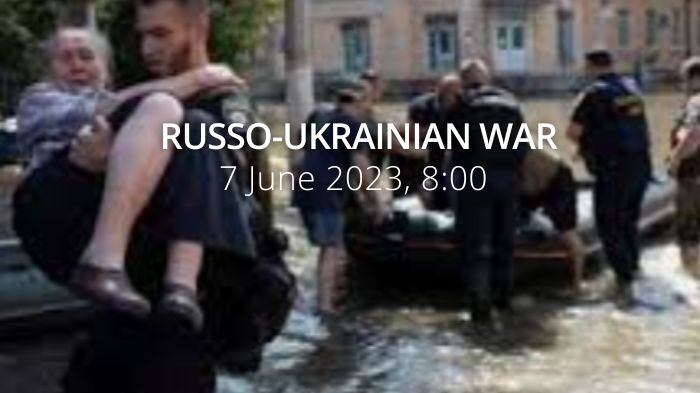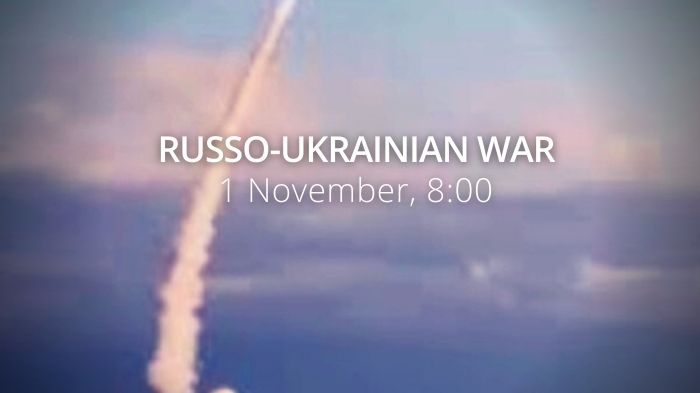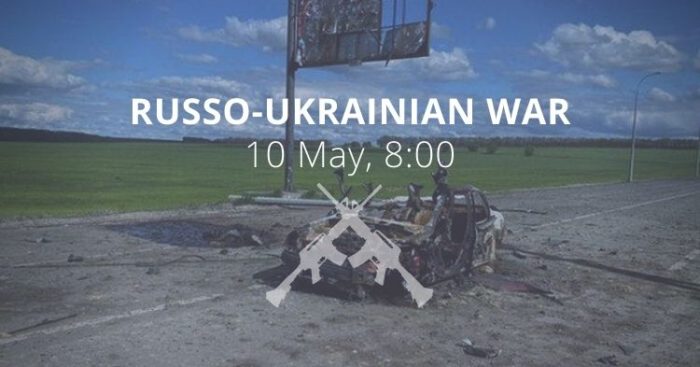Massive flooding of the Dnipro River delta after an explosion at the Kakhovka Hydroelectric Power Plant. Water keeps coming. Ukraine: the damage to the dam and subsequent flooding will not impede Ukrainian counteroffensive preparations.
Daily overview — Summary report, June 7
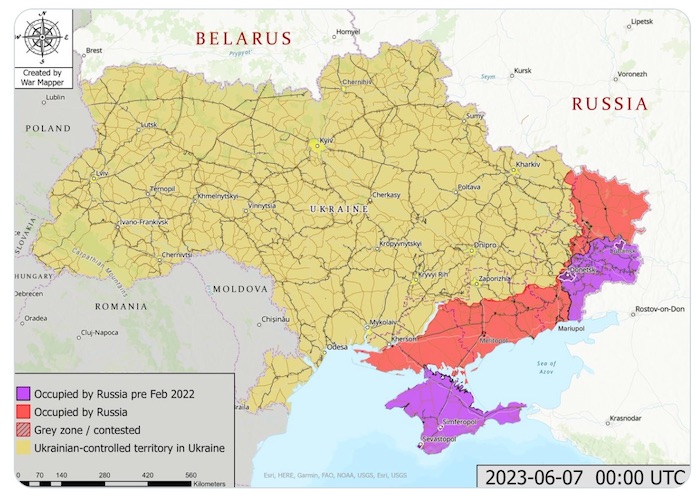
The General Staff’s operational update regarding the Russian invasion as of 18.00 pm, June 7, 2023 is in the dropdown menu below:
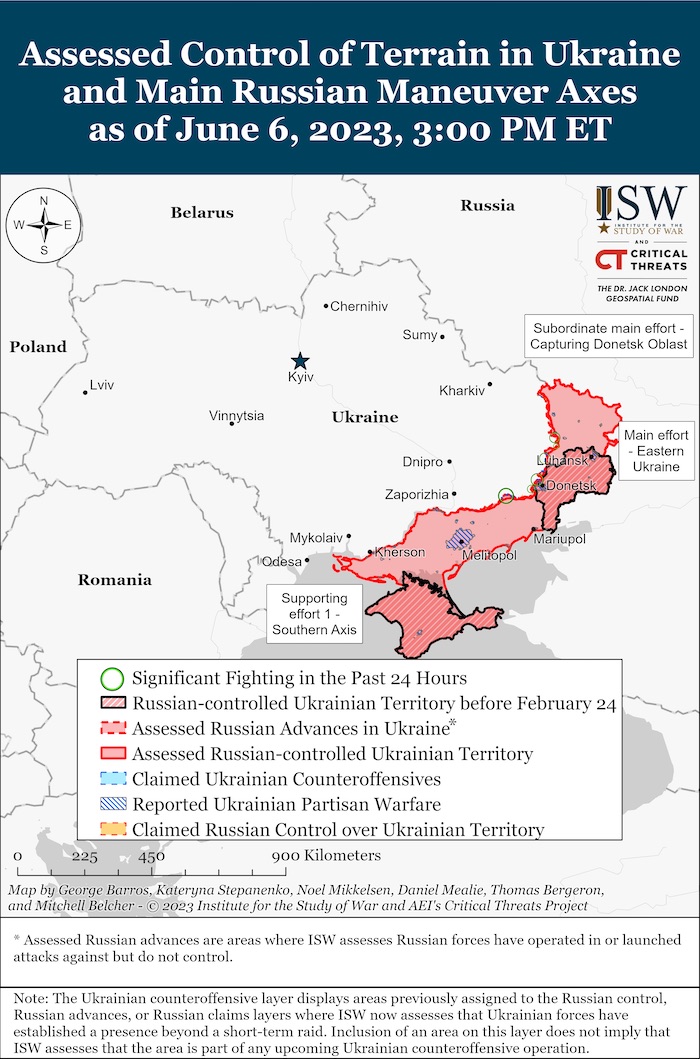



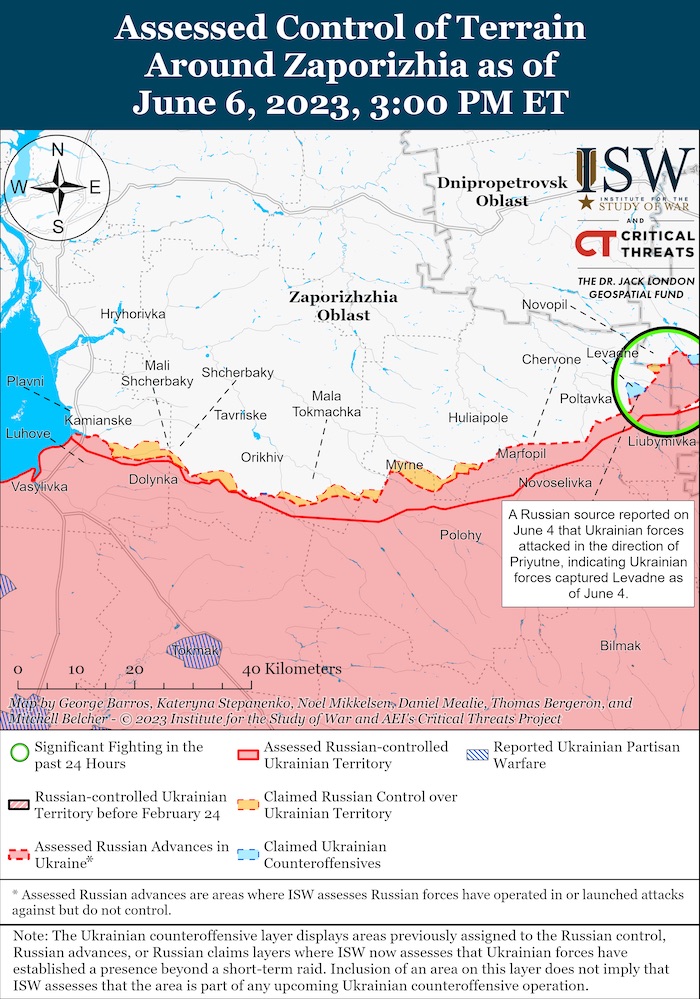

Military Updates
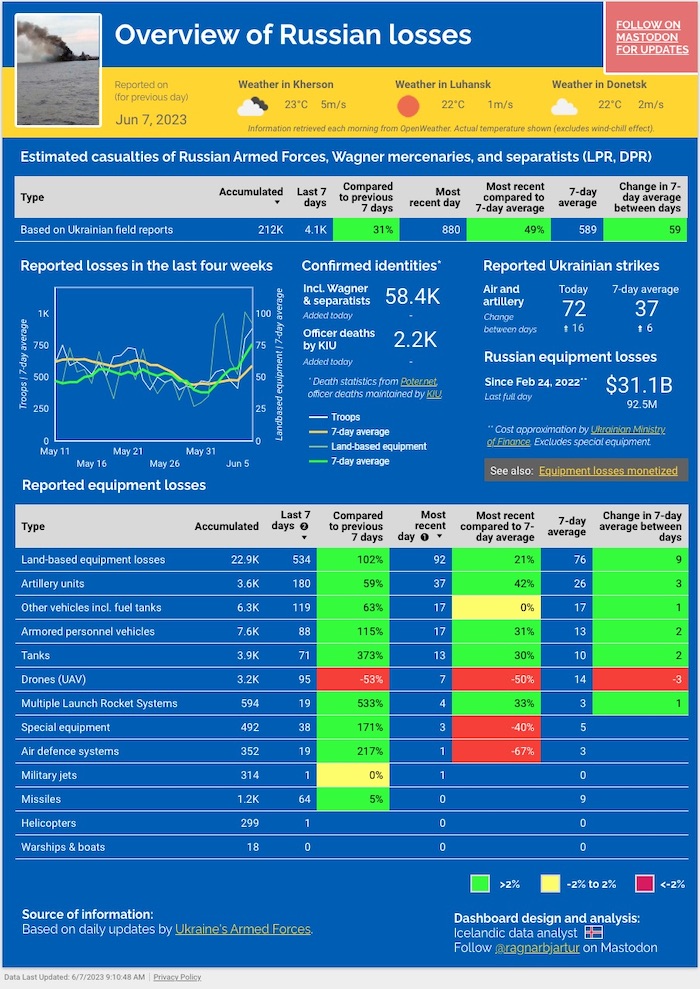
Ukrainian air force destroys all 35 missiles during Russia’s night attack. On 6 June 2023, Ukrainian soldiers intercepted all 35 Х-101/Х-555 cruise missiles launched by Russian forces on Ukraine from the territory of the Caspian Sea, Ukrainian Air Force reported. According to the head of the Kyiv Regional Military Administration, Serhii Popko, air defense units based in the Ukrainian capital detected and shot down over 20 Russian targets from 00:30 to 04:00 a.m. A dormitory, a hospital, and power lines were damaged in the attack, but no casualties were reported.
Russia “buying back” its tank and missile parts from Myanmar and India – Nikkei. Russia is suspected of buying back parts of tanks and missiles previously shipped to Myanmar and India, a Nikkei analysis of customs clearance data shows. The Tokyo-based publication Nikkei analyzed customs clearance data on shipments to Russia, examining records on Russia’s imports of parts for weapons, and found records of Russian repurchases of parts for tanks and missiles that had been exported to Myanmar and India.
Frontline report: Ukraine tricks Russia in the south and establishes wide bridgehead
According to British Defence Intelligence, (last 48 hours):

- The Russian-controlled Kakhovka dam partially failed just before 0300hrs local time on 06 June 2023. By 1200hrs, the entire eastern portion of the dam and much of the hydro and utilities infrastructure was swept away. The water level in the Kakhovka Reservoir was at a record high before the collapse, resulting in a particularly high volume of water inundating the area downstream.
- Zaporizhzhia Nuclear Power Plant, which sits 120km away from the dam, is highly unlikely to face immediate additional safety issues as a result of the dropping water levels in the reservoir.
- The dam’s structure is likely to deteriorate further over the next few days, causing additional flooding.
Losses of the Russian army
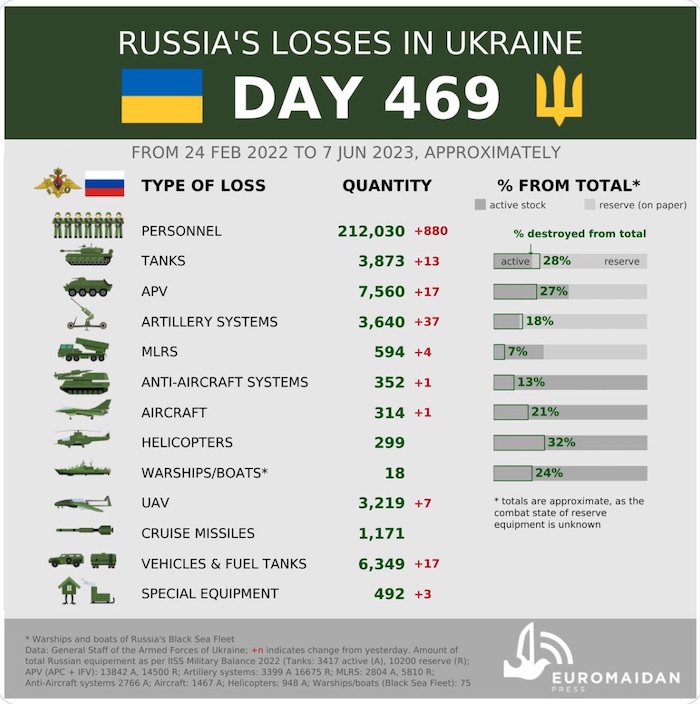
Humanitarian
Almost 3,000 buildings underwater in Ukrainian-controlled part of Kherson Oblast
Environmental
Ukrainian dam engineer rules out self-destruction of Kakhovka dam
Building a new station instead of destroyed Kakhovka HPP will cost $ 1bn and take 5 years – authorities. Ihor Syrota, head of Ukraine’s hydropower plant operator Ukrhydroenerho, has told Forbes that the restoration of the Kakhovka Hydro Power Plant (HPP) will cost an estimated $1 billion and is expected to take five years, if working 24/7. Syrota noted that the reservoir will be depleted to a “dead point” in approximately four days.
One week before Kakhovka explosion, Russia suspended accountability for military-caused hazards. Russian authorities opted against investigating accidents due to “military actions” and terrorism at hazardous sites, including occupied territories in Ukraine, one week before such a mega accident. One week before the explosion at the Kakhovka hydroelectric power station, Russian authorities issued a directive not to investigate accidents at hazardous sites due to “military actions” and acts of terrorism, including in Russian-occupied territories of Ukraine, the Russian media Insider reported.
Ukraine launches investigation into ecocide after Nova Kakhovka attack. Ukraine’s Prosecutor’s Office said it launched a criminal investigation into ecocide committed by Russian troops, who had blown up a dam of the Kakhovka Hydroelectric Power Plant on the occupied territory of Kherson Oblast, unleashing an environmental disaster in the region. “The pre-trial investigation has been initiated in criminal proceedings regarding the facts of ecocide and violations of laws and customs of war,” Ukrainian prosecutors say.
Kakhovka dam explosion poses no threat to Zaporizhzhia nuclear power plant – Enerhoatom. The paused nuclear reactors are not as hot, so water does not evaporate from the cooling pond; however, Russia must leave the nuclear power plant, says agency head.Petro Kotin, President of Energoatom, the national nuclear energy generating company of Ukraine, has dismissed concerns about the potential impact of the Kakhovka Reservoir’s falling water levels on the Zaporizhzhia Nuclear Power Plant following Russia’s destruction of a dam. Kotin stated during the national broadcast that the situation is not critical for the power plant.
Legal
World leaders call Russian attack on Kakhovka plant a “war crime.” On 6 June, world leaders condemned Russia’s attack on the Kakhovka Hydroelectric Power Plant and warned of new sanctions for the destruction of a dam that unleashed 18 cubic kilometers of water and put 16,000 people in Kherson Oblast at risk of flooding.
Support
First of its kind: UK trains Ukrainian military chaplains. Ten Ukrainian military chaplains have recently concluded a two-week training course with their British counterparts, INews reported. This training is a first of its kind to occur on British soil, aiming to equip the chaplains with the necessary religious and practical resources to support personnel through challenging operations, including dealing with bereavement, loss, and mental health difficulties.
Retired Australian F/A-18 Hornet fighter jets could be sent to Ukraine – AFR. Australia, the US, and Ukraine are discussing sending 41 Royal Australian Air Force (RAAF) F/A-18 Hornet fighter jets to Kyiv, rather than scrapping them as planned, The Australian Financial Review (AFR) reports, referring to its sources. According to AFR sources, the US is open to the idea of gifting Ukraine retired F/A-18 fighter jets, as it has recently granted permission for other Western allies to supply Ukraine with advanced fighter jets.
New Developments
US leaning towards Russia’s responsibility in dam destruction, intelligence reports suggest. President Joe Biden’s administration was working to declassify some of the intelligence on the Nova Kakhovka dam destruction, NBC News reported citing its source in the US government. According to the officials, the intelligence is leaning toward Russia as the responsible side for the attack on the dam in Kherson Oblast.
Russian insurgents claim to kill Belgorod counterinsurgency senior officer. The Free Russia Legion has shared a video allegedly proving the death of Colonel Stesyev, while the Russian Volunteer Corps claims control of the village of Novaya Tavolzhanka. Anti-Putin insurgents from the Free Russian Legion (LSR) released a video allegedly showing the site where Russian Colonel Andrey Stesyev, of the “Belgorod” operational group, was killed. The video appears to show a body in Russian military uniform and a bullet-riddled vehicle with a Z on its door. However, the video does not show the deceased’s face or any identifying documents.
Russian messaging on Kakhovka dam explosion inconsistent, challenging official accusation. As waters from the Kakhovka reservoir flood downstream settlements after a night explosion, western media have fallen into the usual “blame game,” reporting that Ukraine and Russia are “trading accusations” for the devastation: Ukraine accuses Russia of detonating the dam on the territory it occupies, while Russia alleges that Ukraine shelled the dam. Ukrainian journalist Kostiantyn Ryzhenko reconstructed the Russian propaganda messaging of the event to reveal a likely Russian military operation to flood Ukrainian troops on the Dnipro islands that went astray.
Assessment
- On the war.
The Institute for the Study of War has made the following assessment as of June 6, 2022:
Damage to the Kakhovka Hydroelectric Power Plant (KHPP) dam in the early hours of June 6 caused massive flooding of the Dnipro River delta, river wetlands, estuaries, and shoreline settlements in Kherson Oblast. Russian and Ukrainian sources began reporting loud noises resembling explosions emanating from the KHPP (across the Dnipro River in the Nova Kakhovka area about 55km northeast of Kherson City) between 0200 and 0230 local time on June 6, followed by reports of rushing water and an overall increase in the water level of the Dnipro.[1] Ukraine’s Kherson Oblast Administration announced the evacuation of several raions (districts) of the west (right) bank of Kherson Oblast as of 0730 local time and reported that the Tyahinka, Odradokamianka, Beryslav, Ivanivka, Mykilske, Tokarivka, Ponyativka, Bilozerka, and Ostriv areas had been partially or completely flooded.[2] Russian Kherson Oblast occupation officials announced the evacuation of the Nova Kakhovka, Hola Prystan, and Oleshky raions.[3] Ukrainian officials noted that over 80 settlements are within the flood zone in Kherson Oblast.[4] General Director of Ukraine’s hydroelectric power plant regulator Ukrhydroenergo Ihor Syrota said that water is draining from the Kakhovka Reservoir at a rate of 15-20cm an hour, which Syrota stated means that the reservoir will be entirely dry in the next four days.[5] A researcher at the Ukrainian Department of Water Bioresources at the Kherson Oblast Agrarian and Economic University, Yevhen Korzhov, noted that the rate of water discharge from the dam may lead to flooding as far downstream as Kizomys, about 120km southwest from the KHPP.[6] A Russian milblogger claimed that the water level in Nova Kakhovka, immediately adjacent to the KHPP, reached as high as 11m.[7] Various Russian sources additionally highlighted footage showing that several east (left) bank settlements, including Oleshky, Korsunka, and Dnipryany, are entirely or nearly entirely underwater.[8]
The International Atomic Energy Agency (IAEA) and Ukrainian officials stated that the drop in the water level at the Kakhovka Reservoir should not affect the safety of the Zaporizhzhia Nuclear Power Plant (ZNPP). IAEA Director Rafael Grossi reported that the drop in the water level at the Kakhovka Reservoir poses “no immediate risk to the safety of the plant” and that IAEA personnel at the ZNPP are closely monitoring the situation.[9] Grossi stated that the ZNPP is pumping water into its cooling channels and related systems, and that the large cooling pond next to the ZNPP will be ”sufficient to provide water for cooling for some months.”[10] Ukrainian nuclear energy operator Energoatom’s President Petro Kotin stated that the fall in the water level at the Kakhovka Reservoir does not directly impact the water level in the ZNPP cooling pond and noted that the ZNPP pool basins are still at the same water level.[11] Ukrainian Chief Inspector for Nuclear and Radiation Safety Oleh Korikov stated that the decrease in water level at the Kakhovka Reservoir will not affect the condition of the ZNPP provided that ZNPP personnel implement established safety measures.[12]
Ukrainian officials stated that Russian forces intentionally destroyed the KHPP dam and suggested that the Russian military did not prepare for subsequent flooding. Ukrainian President Volodymyr Zelensky stated that Ukrainian intelligence indicates that Russian forces conducted an intentional premediated explosion at the dam but did so in a “chaotic” manner that allowed Russian military equipment to be flooded downstream.[13] Zelensky added that the only way to destroy the dam is through mining and emphasized that Russian forces have now occupied the dam for over a year.[14] The Ukrainian Main Military Intelligence Directorate (GUR) stated that Russian forces mined the dam shortly after its capture early in the full-scale invasion of Ukraine and later planted additional mines on the locks and supports of the dam in April 2022.[15] Ukhrhydroenergo stated that Russian forces destroyed the KHPP dam by detonating an explosive within the KHPP engine room.[16] The Ukrainian Resistance Center amplified reporting from the Crimean-based Ukrainian Atesh partisan movement alleging that the Russian 1st Battalion of the 205th Motorized Rifle Brigade (49thCombined Arms Army, Southern Military District) was responsible for the detonation at the KHPP dam.[17] Other Ukrainian officials accused Russia of intentionally destroying the dam out of concerns about potential Ukrainian advances and counterattacks.[18] Ukrainian Southern Operational Command Spokesperson Natalia Humenyuk stated that Russian forces are having to evacuate their forces on the east (left) bank of the Dnipro River because subsequent flooding has disproportionately impacted the Russian-occupied bank of the river.[19] Footage published on June 6 purports to show Russian forces withdrawing from flooded positions, suggesting that these forces were not prepared for the flooding that resulted from the destruction of the KHPP dam.[20]
Russian officials accused Ukrainian forces of destroying the KHPP dam and used the allegations to bolster ongoing efforts to portray Ukrainian assaults elsewhere in Ukraine as immediate failures. Kremlin Spokesperson Dmitry Peskov stated that Ukrainian forces conducted a sabotage attack at the KHPP dam because “Ukrainian armed forces are not achieving their goals” in large-scale offensive operations.[21] This explanation is implausible because Ukrainian forces have not yet conducted large-scale offensive operations. Russian Defense Minister Sergei Shoigu claimed that Ukrainian forces intend to send forces from the Kherson direction to support ”failing” offensive operations elsewhere and thus destroyed the dam to disrupt Russian forces‘ ability to take advantage of weakened Ukrainian defenses on the west (right) bank of Kherson Oblast.[22] This explanation is also implausible because the limited Russian forces on the east (left) bank of the river pose no meaningful threat to the west (right) bank that would require extensive Ukrainian forces to defend against. Russian officials appear to be increasingly trying to immediately characterize Ukrainian offensive efforts as failures and have likely decided to use their accusations against Ukraine concerning the KHPP dam to bolster this informational effort. Shoigu also claimed on June 6 that Russian forces – specifically elements of the Eastern Military District’s (EMD) 433rd Motorized Rifle Regiment of the 127th Motorized Rifle Division (5th Combined Arms Army), the 37th Separate Guards Motorized Rifle Brigade (36th Combined Arms Army), and the 60th Separate Motorized Rifle Brigade (5th Combined Arms Army) – repelled Ukrainian offensives in five different directions in the last three days.[23] Shoigu preposterously claimed that Russian forces have killed and wounded 3,175 Ukrainian servicemembers and destroyed 205 armored combat vehicles and 52 tanks in the previous three days of fighting in Ukraine.[24] Russian sources have previously attempted to paint Ukrainian counteroffensive actions as immediate failures and Russian sources are likely attempting to do the same with what they view as the start of the announced Ukrainian counteroffensive.[25]
ISW has not yet observed clear evidence of what transpired at the KHPP on June 6 and is therefore unable to offer an independent assessment of responsibility at the time of this publication. White House spokesperson John Kirby noted that the US still cannot say conclusively what caused the destruction of the dam but is assessing reports that “the blast was caused by Russia.”[26] NBC additionally reported that the US has intelligence indicating Russia’s responsibility for the dam’s destruction but is currently working to declassify relevant information.[27] Various European officials made statements indicating that they believe Russia is involved and underlining the resulting humanitarian impacts of the flooding.[28]
Statements by US and European officials are generally consistent with ISW’s October 2022 forecast that the Russians have a greater and clearer interest in flooding the lower Dnipro despite the damage to their own prepared defensive positions and forces than the Ukrainians.[29] ISW previously assessed on October 21, 2022, that Ukraine has no material interest in blowing the dam and pointed out that 80 settlements would risk flooding.[30] Ukrainian officials confirmed on June 6, 2023, that 80 settlements risk flooding as a result of the damage.[31] ISW further assessed that by contrast, Russia may use the flooding to widen the Dnipro River and complicate Ukrainian counteroffensive attempts across the already-challenging water feature.[32] Russian sources have expressed intense and explicit concern over the possibility that Ukraine has been preparing to cross the river and counterattack into east bank Kherson Oblast.[33] Available footage from June 6, corroborated by claims made by Russian milbloggers, suggests that the flooding washed away Ukrainian positions near the Dnipro shoreline and forced Ukrainian formations to evacuate while under Russian artillery fire.[34]
Ukrainian officials acknowledged that Russian formations and positions on the east bank may have been caught off guard and threatened by the flooding due to the topography of the area, some Ukrainian officials suggested that this was a result of the chaotic handling of the intentional detonation of the dam by Russian forces.[35] Some Russian sources indicated that the damage to the dam could threaten the water supply to occupied Crimea, but ISW previously noted that Crimea survived without water from the Dnipro River in the years between Russia‘s initial illegal annexation in 2014 and when water access was restored following the 2022 full-scale invasion.[36] There is also the possibility, of course, that pre-existing structural damage to the dam eventually caused breakage and flooding, as some sources have additionally suggested, although reports of noises like explosions are not necessarily consistent with this notion.[37] ISW cannot offer a definitive assessment of responsibility for the June 6 incident at this time but finds that the balance of evidence, reasoning, and rhetoric suggests that the Russians deliberately damaged the dam.
Ukrainian officials offered assurances that the damage to the dam and subsequent flooding will not impede Ukrainian counteroffensive preparations. Zelensky emphasized that the “detonation of the dam did not affect Ukraine’s ability to de-occupy its own territories.”[38] Ukrainian Joint Forces Commander Lieutenant General Serhiy Nayev noted that the Ukrainian command has already taken into account Russia’s propensity for ”insidious actions” and that as a result any potential planned counteroffensive actions will not be impacted in areas where there is flooding.[39] It is additionally noteworthy that the areas of the theater that are impacted by the flooding (those within a 120km flood radius between Nova Kakhovka and Kizomys) are geographically very far removed from areas of the frontline where ISW has observed recent combat activity in the past few days.[40] The flooding of the lower Dnipro will not likely have any impact on the areas that have seen active fighting recently.
Russian forces conducted another large-scale missile strike across Ukraine on the night of June 5-6. Ukrainian military sources reported that Russian forces launched 35 Kh-101/555 cruise missiles from six Tu-95 bombers over the Caspian Sea and that Ukrainian air defense shot down all 35 missiles.[41] The Ukrainian General Staff also reported that Russian forces targeted Kharkiv City with S-300 surface-to-air missiles.[42] Ukrainian Southern Operational Command Spokesperson Natalia Humenyuk noted that the fact that Russia only launched Kh-101/555-type missiles and returned all sea-based Kalibr missile carriers to their base points before the strike may suggest that Russia is running out of Kalibrs to launch.[43] Humenyuk’s comments are consistent with periodic Ukrainian tallies of the numbers of Kalibrs remaining and Russia’s capacity to produce them. [44] The Russian Ministry of Defense (MoD) claimed that Russian aerospace forces conducted the strike with long-range air-launched missiles against Ukrainian ”decision-making centers” and struck all intended targets.[45] The UK MoD reported on June 5 that Russian forces have recently heavily relied on Iranian drones to try to attrit Ukrainian air defense missile capabilities, but the fact that Ukraine is still managing to employ air defense systems against cruise missiles to such high effect suggests that these Russian efforts have been largely unsuccessful.[46]
Russian sources claimed that the pro-Ukrainian all-Russian Russian Volunteer Corps (RDK) and the Freedom of Russian Legion (LSR) are gone from a border settlement in Belgorod Oblast as of June 6. Russian sources published footage of Russian forces stating that they are in control of Novaya Tavolzhanka (a small village about 3km from the Kharkiv-Belgorod Oblast border) and that RDK and LSR elements are no longer present in the settlement.[47] The Ukrainian Main Military Intelligence Directorate (GUR) reported that a senior Russian officer of the Belgorod Operational Group, Colonel Andrey Stesev, was killed in action in Novaya Tavolzhanka overnight on June 4-5.[48] The Freedom of Russia Legion (LSR) claimed on June 6 that its forces killed Stesev.[49]
Wagner Group financier Yevgeny Prigozhin continued to directly threaten the Russian Ministry of Defense (MoD) and the Russian military command if they do not fulfill his demands for a larger independent army and political influence in Russia. Prigozhin threatened on June 5 that Wagner forces will “go to Belgorod” without explicit permission from the Russian MoD if the Russian military command does not “liberate” Belgorod Oblast border areas from various all-Russian pro-Ukrainian groups operating on Russian soil and improve the situation in Shebekino (a settlement 6km from the international border).[50] Prigozhin presented letters that he reportedly received from Shebekino residents who complained that the Russian military is neglecting their safety and called on Wagner to defend them. Prigozhin also sarcastically stated that the Russian MoD might be considering “using a nuclear weapon on their own territory” when discussing the Russian military command’s unwillingness to defend Belgorod Oblast as part of his attempt to exaggerate the Russian MoD’s disinterest in defending its own citizens. Prigozhin’s comments about such nuclear use, like much of his heavier sarcasm, were not meant to be taken literally. Prigozhin also reiterated that he had requested 200,000 troops and ammunition to seize Donetsk and Luhansk oblasts, and this demand may be reflective of his efforts to blackmail the Kremlin into giving Wagner forces additional resources and expanding its influence over the Russian MoD. Prigozhin also noted that Russia will not be able to fix its long-standing military incompetency at this time without executing Russian military officials responsible for military failures in Ukraine – and noted that failure to do so might upset Russian society.
Key Takeaways
- Damage to the Kakhovka Hydroelectric Power Plant (KHPP) dam in the early hours of June 6 caused massive flooding of the Dnipro River delta, river wetlands, estuaries, and shoreline settlements in Kherson Oblast.
- The International Atomic Energy Agency (IAEA) and Ukrainian officials stated that the drop in the water level at the Kakhovka Reservoir should not affect the safety of the Zaporizhzhia Nuclear Power Plant (ZNPP).
- Ukrainian officials stated that Russian forces intentionally destroyed the KHPP dam and suggested that the Russian military did not prepare for subsequent flooding.
- Russian officials accused Ukrainian forces of destroying the KHPP dam and used the allegations to bolster ongoing efforts to portray Ukrainian assaults elsewhere in Ukraine as immediate failures.
- ISW has not yet observed clear evidence of what transpired at the KHPP on June 6 and is therefore unable to offer an independent assessment of responsibility at the time of this publication.
- Russian forces conducted another large-scale missile strike across Ukraine on the night of June 5-6.
- Russian sources claimed that the pro-Ukrainian all-Russian Russian Volunteer Corps (RDK) and the Freedom of Russian Legion (LSR) are gone from a border settlement in Belgorod Oblast as of June 6.
- Wagner Group financier Yevgeny Prigozhin continued to directly threaten the Russian Ministry of Defense (MoD) and the Russian military command if they do not fulfill his demands for a larger independent army and political influence in Russia.
- Ukrainian officials offered assurances that the damage to the dam and subsequent flooding will not impede Ukrainian counteroffensive preparations.
- Russian forces conducted limited ground attacks along the Svatove-Kreminna line.
- Russian sources claimed that Ukrainian forces continued ground attacks north and southwest of Bakhmut, and Russian forces continued limited offensive operations along the Avdiivka-Donetsk line.
- Ukrainian forces continued ground attacks in southwestern Donetsk and in eastern Zaporizhzhia oblasts.
- Wagner Group financier Yevgeny Prigozhin claimed that the Russian 72nd Separate Motorized Rifle Brigade is part of the irregular 6th Division.
- Russian officials and occupation authorities continue efforts to use infrastructure projects to integrate occupied territories into Russia.




